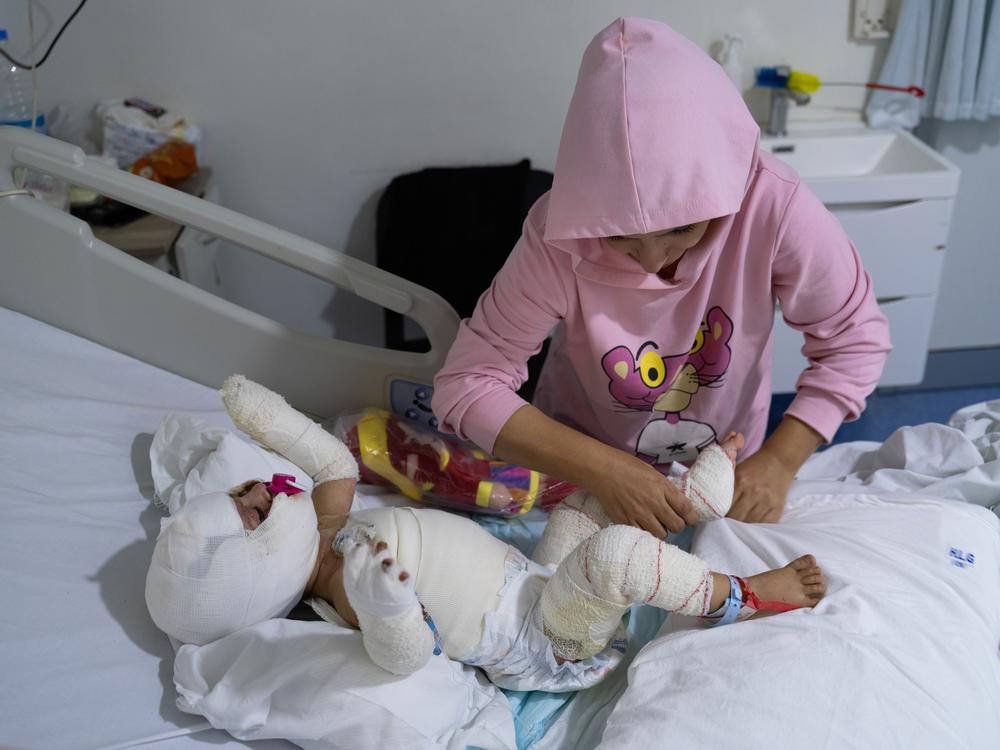Section Branding
Header Content
Lebanon's only burn unit sees a surge of patients as Israel strikes the country
Primary Content
BEIRUT — Eighteen-month-old Ivana Likbiri was playing with her older sister on the balcony of their home one recent morning when Israel’s airstrikes came.
In a flash, the wood terrace the two little girls were playing on went up in flames.
“I don’t know what divine strength filled me, but I grabbed my girls from the fire and threw them over the balcony to save them,” says Ivana’s mother, Fatima Zayoun.
Zayoun’s time is now spent between two hospitals where her daughters are receiving treatment for severe burns. On this day, she’s at the bedside of little Ivana, whose arms, legs, head and face are all wrapped in bandages with only enough room for a pink pacifier to soothe her. The next day, Zayoun will swap places with her husband, who has been at the bedside of their 7-year-old Raha. She’s recovering at a different hospital that still had open beds when the family made it to Beirut from their village of Deir Qanoun al-Nahr in southern Lebanon.
Zayoun and her family are now among Lebanon’s 1.2 million displaced people who have had to flee their homes as Israel has intensified its airstrikes across the country in its fight against the Iran-backed political and militant group Hezbollah.
Some have settled into new homes in new neighborhoods, others are taking shelter in schools or nightclubs. Zayoun has no idea where her family will end up.
“I’ve only been between the two hospitals and don’t know where we’re going to actually live,” she says, reflecting on how she had planned to evacuate her family the morning of the Sept. 23 strike right after they finished breakfast. “We don’t have a place, we don’t have an apartment. I’m just exhausted and I feel broken and numb.”
All she’s certain of at this moment is that her family will never return to the village they fled, not even after the war ends. All the good memories from their life there are overshadowed by the horrors of the airstrike.
Lebanon’s only burn unit
Ivana is one of 22 patients being treated in the burn unit of the Geitaoui Hospital in Beirut. It’s a private medical center with the only burn unit in Lebanon. Only the most critically injured victims are transferred to the hospital.
With Israel’s airstrikes intensifying, the hospital has more than doubled its number of beds, but it still can’t keep up with the unprecedented number of casualties with severe burns.
“Every day we get calls from hospitals all over the country to transfer patients, but we can’t accept everybody because of the big flow of patients,” says Dr. Ziad Sleiman, one of the hospital’s plastic and reconstructive surgeons. “We have to choose the most complicated cases and turn away the others.”
Available beds are just part of the struggle.
Medical staff have fled, while some have been hit
Some of the medical staff have lost their homes in airstrikes and are among the displaced, taking time off to pick up the pieces of their own lives.
“We have transferred staff from other wards and we are actively training them on how to treat burns,” says Sleiman, who has worked at the hospital for two decades and has never seen it so overwhelmed and at such a financially vulnerable time for the country.
Before the war, Lebanon was already mired in an economic crisis. Years of government and banking sector mismanagement led to the collapse of the financial system in 2019. That triggered severe shortages of food, fuel and medicine and set off an era of hyperinflation. Health care costs soared making it difficult for people to get treated for even serious illnesses and the salaries of doctors and nurses plunged. Medical staff left the country in droves.
It’s against that enduring backdrop that hospitals are now in the grips of a war that has killed more than 2,500 people and left almost 12,000 wounded in Lebanon, according to the country's Health Ministry.
And medical workers have not been spared.
Clinics, ambulances, and search-and-rescue teams have been caught in the Israeli military’s line of fire. More than 150 medical and emergency workers have been killed in Lebanon since last October, when fighting first broke out between Hezbollah and Israel, according to Lebanon's health minister, Dr. Firass Abiad.
Some look at Israel’s war in Gaza, with hospitals there relentlessly caught in the crossfire and more than 800 health care workers killed, according to the United Nations human rights office, and wonder if they’re staring down the same fate.
Dr. Sleiman can’t fathom having his hospital come under fire like that. But treating victims of this war like 18-month-old Ivana Likbiri, suggest anything is possible.



